
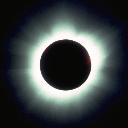

| Images of Africa |

|
| by John Walker | ||
Click on small images to view a larger picture.
| Victoria Falls | |
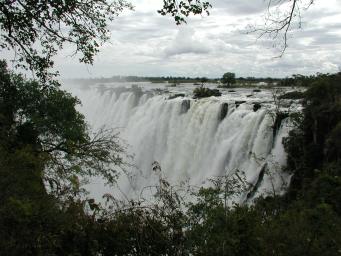
| No photograph can do justice to Victoria Falls, Mosi-oa-Tunya "the smoke that thunders" in the local language. The waterfall, where the Zambezi river plunges more than 100 metres into the first of a series of narrow gorges, raises a permanent cloud of mist visible from dozens of kilometres away. Close to the falls the roar is overwhelming, with lots of low frequency components you feel rather than hear. Because the falls are at the start of a series of zig-zag gorges, there is no vantage point on the ground from which the entire falls can be seen or photographed. This is a view from the Mosi-oa-Tunya National Park in Zambia, where you can walk out on the "Knife Edge" cliff and see the falls close-up. Depending on the wind, you may only be able to barely glimpse the falls through the mist. What is absolutely certain is that you will end up utterly soaking wet from the "mist" (actually, think torrential rainstorm) when the wind blows in your direction. Unless you thought to bring a watertight camera case, your camera should probably spend most of the time sealed in a plastic bag. |
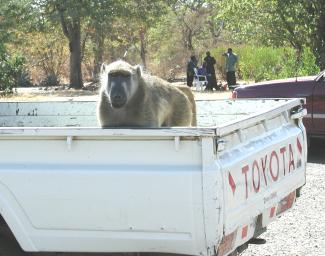
| The Zambezi river forms the border between Zimbabwe and Zambia. The border crossing is a bridge which affords a magnificent view of the falls. Every time you cross the bridge you have to go through exit and entry formalities for the respective countries, so you can end up with a lot of stamps in your passport. If a lot of people are waiting to cross the border it can take a while, but not to worry because there is ample entertainment. Several troops of baboons (Papio ursinus) frequent the area and are into everything. It is a bad idea to leave anything in an open vehicle where these bad actors may lay their not-so-gentle hands upon it. They also have extremely impressive teeth which they're apt to show you if you get too close. Would you want to put your arm into the back of this pick-up truck to rescue your camera? |
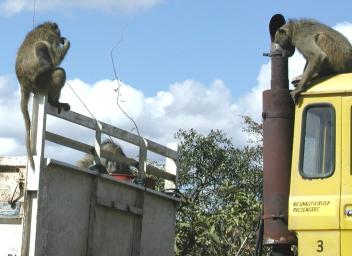
| The baboons at the border post examine vehicles much more thoroughly than do customs inspectors. Apparently these fellows neglected to read the sign on the cab of the truck. (Click the picture to see a larger image.) Baboons aren't apes--they're monkeys--the largest species, with males tipping the scales at up to 40 kg. They're obligate quadrupeds: kind of like evil dogs with hands. |
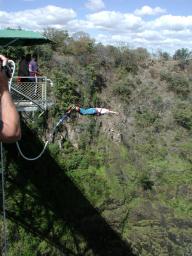
| On the side of the bridge between Zimbabwe and Zambia looking away from the falls is a platform from which the truly insane bungee jump. The nutter caught in free fall in this picture wasn't satisfied with only one jump--he availed himself of the free second go afforded those who purchase a video of their first jump. Such a deal.... |
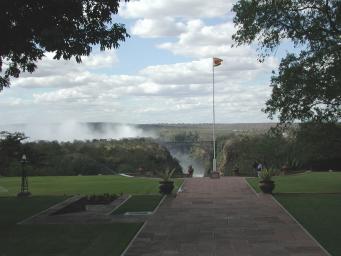
| The Victoria Falls Hotel, on the Zimbabwe side of the river, is a magnificent colonial era establishment. The ambiance is such that you almost expect to run into Cecil Rhodes in the bar or Hercule Poirot in the lobby. From the veranda there is a stunning view of the falls and the Zim/Zam bridge. Baboons frequently cavort on the lawns and in the trees, and groups of Banded Mongoose (Mungos mungo) can occasionally be seen foraging on the grounds. |
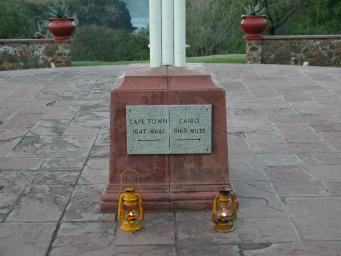
| The Victoria Falls Hotel was built in 1904 to accommodate passengers on the "Cape to Cairo" railway envisioned by Cecil Rhodes. The British Empire ended before the railway got anywhere close to Cairo, but the flagpole at the hotel recalls the dream. |

| Victoria Falls is a major tourist attraction, and there are the usual tourist-type things to do in the vicinity. Since we went as part of a package tour, we were booked for some things we probably would have avoided if on our own, such as a performance of "authentic African dances" put on every night for the benefit of tourists (including a busload of Japanese, all of whom wore little earphones to hear a translation of the English commentary by their tour guide). I can't vouch for the authenticity of the dances, but some were quite remarkable, including these guys who danced entirely on stilts. Sheesh--I get dizzy just being as tall as I am! Another act involved a bloke picking up a section of railway rail massing about 40 kg with his teeth...I don't recall precisely why. It was after this performance that we departed for a Boma ("place of eating") dinner, where we savoured that African delicacy, the Mopani worm (actually the caterpillar of the emperor moth Imbrasia belina which feeds on the leaves of the Mopani tree, Colophospermum mopani). Yum! |
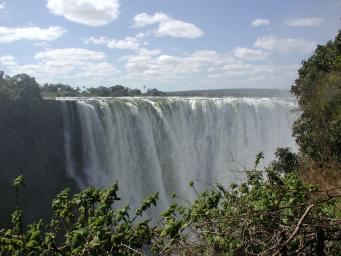
| It's just a few minutes walk from the Victoria Falls Hotel to a trail with many exquisite (albeit extremely wet) vantage points from which to view the falls. Our visit, in mid-winter, was shortly after the end of the rainy season when the Zambezi is near its peak. Spring and summer bring the dry season, during which the flow of the river is greatly diminished. Sections of the falls, including this one, go entirely dry. |

| After taking in the glorious vistas of the falls, the only thing remaining to make a perfect day is to, you know, check E-mail. Fortunately, a few minutes walk from the hotel brings you to one of two Internet Cafés in Victoria Falls. This establishment has about 10 PCs which share what appeared to be a 56 Kb dial-up connection--perfectly adequate for E-mail and confirming that all was well at Fourmilab in my absence. |
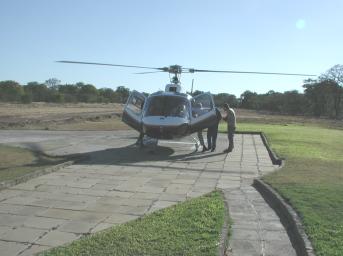
| As I mentioned, there is no place on the ground from which you can fully take in the majesty of Victoria Falls. So...take to the air! A small airport on the Zambia side of the border operates microlight and helicopter flights over the falls. The microlights were all booked the day we had free for such activities, so we opted for the helicopter, which accommodates four people plus the pilot. You can sign up for either a 15 or 30 minute flight--we opted for the 15 minute excursion which, of course, goes far more quickly than you'd imagine. |
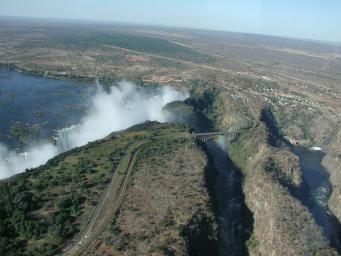
| Here's a view of Victoria Falls from the helicopter. (You'll probably want to click the image to see a larger picture, where you'll find this caption waiting for you at the bottom.) At the left the broad Zambezi plunges 100 metres into the first gorge, raising the eternal cloud of mist and forming a rainbow visible in front of the bridge across the gorge. We're overflying Zimbabwe at the moment; the "Knife Edge" from which the first photo of the falls above was taken protrudes from the Zambia side above and to the left of the bridge. The bungee jumping platform is visible at the centre of the bridge, near the top of the rainbow. Electricity generation in Zambia is in excess of 99% hydroelectric; a power station is visible at the right of the image, along with outflow from the turbines into the gorge. After the falls, the Zambezi traverses a series of zigzag gorges, the first two of which are visible here. |
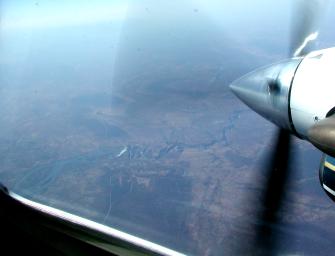
|
An overview of Victoria Falls and the series of gorges below it is
seen in this photo from the copilot's seat of the Beechcraft
King Air we chartered from Maun in Botswana to Mfuwe, Zambia.
We happened to overfly Victoria Falls, which is visible in this image
through the propeller of the right engine. To the left, the
Zambezi approaches the falls, with numerous islands in the
river. The mist from the falls makes a white line delineating
the first gorge. Afterward the river traverses the zig-zag gorges and
then meanders through a deep, sinuous gorge toward the right.
The town of Victoria Falls, Zimbabwe is visible below the gorges to the right of the falls, with the airport to its left. |
| The Crocodile Ranch | |
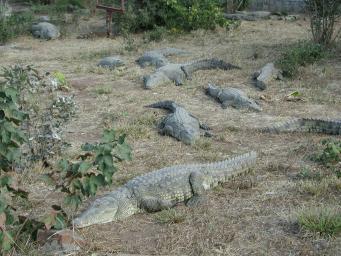
| A few kilometres on the Zambian side of the Zimbabwe/Zambia border at Victoria Falls is a crocodile ranch. The owners raise Nile Crocodiles (Crocodylus niloticus) commercially for leather and meat at a larger facility elsewhere in Zambia, but this is purely a tourist attraction which exhibits mischievous "problem crocodiles" removed from the Zambezi river. Although called the "Nile Crocodile", the species is found in rivers and swamps throughout non-arid regions of Africa. Some of the crocs here are huge--up to five metres in length. You can get quite close to the crocodiles on elevated walkways which criss-cross the facility. The Sun was out when we visited and most of the crocodiles were basking in the fields. There are large pools of water, and it is extremely spooky to see how an enormous crocodile can simply disappear as it glides in and sliently submerges. Swimming in the Zambezi is an extraordinarily poor idea; if you manage to evade the crocodiles, you'll probably be killed by a hippopotamus. |

| The crocodile ranch is also home to a modest collection of African snakes including this Egyptian Cobra (Naja haje) which put on a fine display without any prompting. There was also a Puff Adder (Bitis arietans--trenchant name, don't you think?) which hissed constantly all the time we were there. |
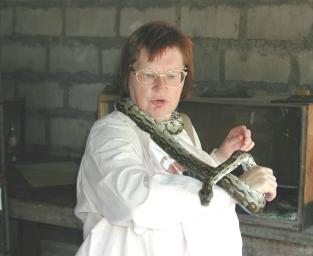
| Roxie and friend at the crocodile ranch. The snake is an African Rock Python (Python sebae). |
| Botswana | |
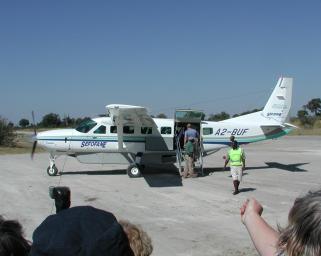
| We departed Victoria Falls on the morning of June 17th, 2001 for Vumbura Camp in the Okavango Delta in a chartered Cessna Caravan, shown here on arrival at the Vumbura airstrip. We made a brief stop at the airport in Kasane to clear Botswana customs before proceeding to Vumbura Camp. |
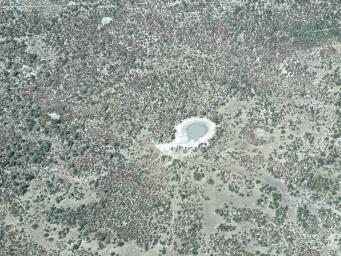
| In the semi-arid regions of southern Africa, wildlife survives the dry season by visiting waterholes like this one, photographed on the flight into Vumbura Camp, Botswana. The trails used by animals which frequent the waterholes are clearly visible extending radially outward into the bush. Elephants play an important rôle in maintaining waterholes, as their wallowing for mud baths keeps the waterholes from filling up with silt. |
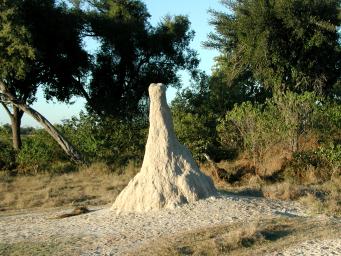
|
You'd expect the Webmaster of Fourmilab
to have a thing about ants, but I also rejoiced to encounter the
next best thing--termites--upon arriving in Botswana. These are
serious termites, not the tiddlers that munch on the lumber
of your house! This termite mound is almost three metres in
height. Termites build them with an intricate ventilation system
which maintains a close to constant temperature inside--human
architects have recently applied this insect-developed technology to
office buildings.
Termite mounds are often found adjacent to trees (there was a huge one next to the tree which shaded our tent at Vumbura Camp). They are often the first step in the local ecosystem succession; the termite mound raises soil from the low-lying and frequently flooded river delta, which is then colonised by small plants and eventually trees. This is a relatively new mound, adjacent to a largely flooded area. Termites stay within the mound during the winter season; they are active only during the hot summer months. |
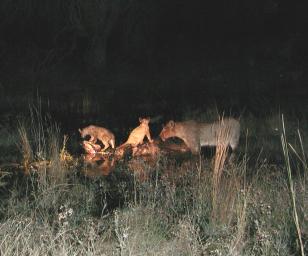
|
The evening of our arrival at Vumbura Camp we went on our first
"wildlife drive". This amounts to boarding small boats at the
camp (on an island in the river delta, now returning to its
normal winter state after 11 years of drought) which ferry us
to open Land Rovers in which we then ramble over the
countryside looking for animals. There is a tremendous amount
of bouncing about, fording flooded areas between islands in the
delta, and, after sunset, keeping one's eyes peeled for the
glint of eyeshine as the "spotter," who sits on a seat above
the front tyre of the vehicle, sweeps a spotlight back and
forth.
Here's something you don't see every day--a lioness (Panthera leo) who's recently killed this Cape Buffalo (Syncerus caffer) watching her cubs chow down! There were three lionesses and a total of eight cubs at this kill: lionesses hunt together...clever girl...and share their kills. After making a kill, the lioness will usually allow the cubs to eat their fill before feeding herself. A buffalo can be several days' food for a number of lions. |

| The next morning we set off to revisit the site of the buffalo kill to see what had transpired overnight. It was easy to find--an adjacent tree was full of Hooded Vultures (Necrosyrtes monachus), "just waiting". |
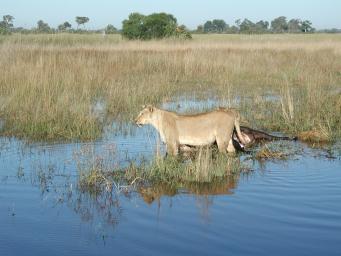
| Near the tree, the water buffalo was pretty much where we left it the previous night, with two lionesses and their cubs in attendance and feeding in relays. This lioness is calling her cubs to the kill from the island where they were cavorting beneath the vulture tree. Lionesses make the silliest sound calling their cubs--it's more like the "meep" of a housecat than the roar you expect from the Queen of Beasts. |
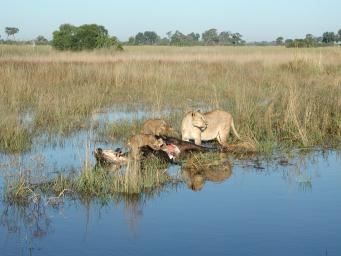
| Lunchtime, kiddies! Two cubs savour the delectable organ meat of the deceased bovid (whose head and one ear are visible at the left) as mom glares at a male lion approaching from the right. The lionesses having made the kill, he's arrived for meal time. |

| If you're a lion, a dead water buffalo has many admirable qualities which, regrettably, have but a short half life when said buffalo is left in warm and shallow water. Here the lioness is attempting to drag the carcass from the water onto dry land at left. She managed to rotate the carcass "four in the air", but no further...there's never a fork lift when you need one. |

| The male lion who occasioned the withering stare from the lioness above decided to delay his entrance until the cubs had returned to playing beneath the vulture tree. Here's the noble beast striking a pose while his harem loads up on protein. This is not a telephoto shot--the lions in this picture are about as close as they appeared from the Land Rover. Several generations of lions have lived and died since they last were hunted in this area, and lions do not consider the silhouette of a Land Rover as a threat. Passengers on game drives are advised to never stand up in their seats, as that creates a profile which animals may consider threatening. |
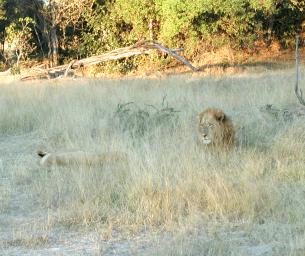
| Here's another pair of lions we encountered later in the day. This was a mated pair--trust me--but don't look for proof here at G-rated Fourmilab! Neither lion paid the slightest attention to our Land Rover. |
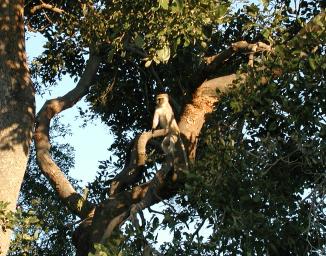
| Shortly before we stopped for "sundowners", we came across this Vervet Monkey (Cercopithecus aethiops) who clearly believed this was not only his tree but his turf, where no Land Rovers full of other primates were welcome. He was outraged! Again and again he jumped to his feet and hurled imprecations in our direction. I always thought it was a joke that monkeys said "ook!". This chappie screeched at us again and again, doing everything short of waving a "nakes go home" sign in our face. We eventually motored on, stopped, and had a beer. |
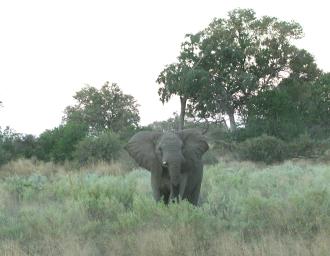
| As dusk approached, we came upon a group of African Elephants (Loxodonta africana) passing from right to left in front of our Land Rover. Most proceeded into the trees, but one bull clearly had an attitude problem. After the rest of the family had disappeared into the bushes, he turned and looked at us head-on. Clearly, having lost one tusk in an earlier dispute, he was not averse to violence. Fortunately, he settled for a intimidating glare as opposed to an obliterating charge. |
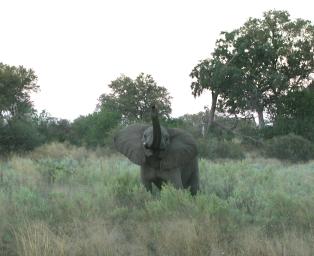
| Shortly after the previous photo was taken, a second Land Rover full of wildlife gawkers arrived on the scene. "Now he's really pissed!" Indeed.... The elephant, defending his entourage in the bush behind him, trumpeted a warning, "This far, and no further!". They say that if he does this while flapping his ears it's just a warning and he doesn't mean business. He wasn't flapping his ears. |

| There are sunsets, and then there are African sunsets. Botswana has what may be the most transparent skies of any landlocked area on Earth. The nation is essentially unpopulated--fewer than 1.5 million people in an area larger than Texas with most in a few urban centres. Unlike central Australia, there is abundant humidity and precipitation to clear the air of dust. This is a Botswana sunset...the land extends to the horizon and the cosmos reveals its infinite depth above. Indeed...not long after sunset the pellucid skies of Botswana render the zodiacal light almost bright enough to read a newspaper, the Magellenic clouds obvious, and the bulge at the centre of our galaxy apparent at the slightest glance. So transparent is the sky that on the previous day I spotted Venus in broad daylight, clearly visible against the blue sky just before noon. |
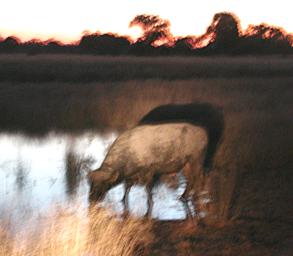
| The Cape Buffalo is considered one of the most dangerous of Africa fauna: it's big, fast, dumb, and peevish. I saw a buffalo in a thicket near Victoria Falls but it was sufficiently concealed to not show up in a photo. The second buffalo we saw, having already been killed by lions, didn't exactly count as "on the hoof", so we were pleased to spot several buffalo, including this one, after dusk. This is a hand-held long exposure illuminated primarily by the spotter's light, hence the prominent shadow. Consequently, the picture's a bit blurred, but it's the best shot of a buffalo I managed to get. |
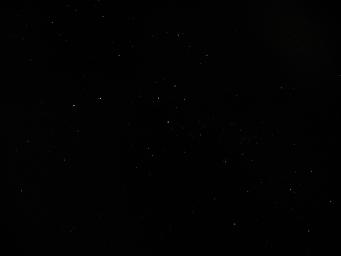
| The night sky in Botswana is awe inspiring. One regret was that the 12 kg luggage restriction imposed by bush planes precluded bringing a telescope to explore the wonders of the southern sky under such ideal conditions. The Olympus 3040 digital camera I used for all of these photos has a f/1.8 lens, CCD sensitivity equivalent to ISO 400 film, and a maximum exposure time of 16 seconds, so I decided to see what I could do with the equipment at hand. I set up the camera on the folding tripod I used for the eclipse photos and took this 16 second time exposure of the Southern Cross, with Alpha and Beta Centauri visible to the left. The sensitivity of the camera was not, regrettably, sufficient to capture the Milky Way, which extended from horizon to horizon in the moonless sky. |
| Zambia | |

| Hippopotamus (Hippopotamus amphibius) are abundant in the rivers of southern Africa: we saw (and heard) them in the Zambezi and Luangwa in Zambia, and the Okavango in Botswana. What you usually see is illustrated here--just the silhouette of the head or only the eyes emerging from the water, and that only sporadically. We spotted these hippos in the Zambezi from a small boat we took from The River Club where we were staying on the Zambia side. Hippos usually come out of the water by night and only infrequently by day. The inset shows a group of four hippos we spotted on an island in the Zambezi. The pink colour is not a photographic artefact--hippos secrete a pink, oily substance which acts as sunscreen and keeps their skin moist when they're out of the water; they were once thought to sweat blood, which actually only Windows software developers do. Despite their ungainly appearance on land, they move quickly and gracefully in the water. They are aggressive, have little fear of humans, and are considered among the most dangerous of African mammals. When startled while grazing at night, a hippo will bolt for the nearest water, trampling anything and anybody in its path. |
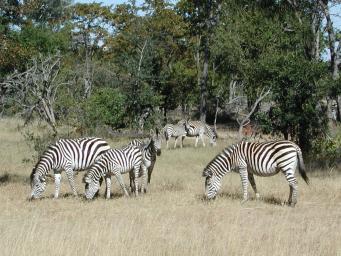
| Shortly before crossing the border from Zambia to Zimbabwe, we visited a small wildlife reserve on the Zambia side of the Zambezi. While not boasting the variety of species of the larger reserves we visited later, this was our first opportunity to encounter African wildlife close-up, including this herd of Burchell's Zebra (Equus burchelli). |

| The main reason for visiting the reserve on the Zambezi is an opportunity to spot a White Rhinoceros (Ceratotherium simum), which has been re-introduced into the area from South Africa. "But it's black, not white!", you immediately exclaim. "White" is, in fact, a misleading anglicisation of the Afrikaans wijde, meaning "wide", referring to the shape of its upper lip, which is adapted for grazing. The more common Black Rhinoceros (Diceros bicornis), which principally browses on leaves and twigs, has a pointed prehensile upper lip. The white rhinoceros is second only to the elephant as the largest land mammal, with large bulls weighing in excess of 2500 kg. Despite their mass, white rhinoceros are quite agile, able to run as quickly as 40 km/hour. Fortunately, they are not as aggressive as the black rhinoceros, and are more prone to run away from a provocation than charge. |

| Weather forecasts indicated an excellent probability of cloudless skies for the eclipse, but one worry was obscuration due to smoke from the winter burning of fields widely practiced in southern Africa. Indeed, when we flew into Mfuwe airport in Zambia the day before the eclipse, the sky was murky with it, with several pillars of smoke rising into the sky, including this one from a burn near the airport. Fortunately, eclipse day had been declared a holiday in Lusaka, and there was little or no smoke in the air at our viewing site. |
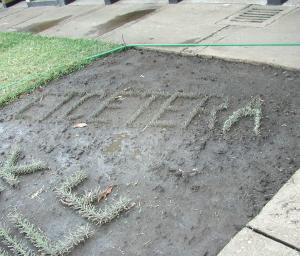
| Outside the Mfuwe Airport is garden planted with a succulent plant spelling out the names of major species found in the areas. So many species, so little space.... We never did manage to spot the wild Etcetera (Etcetera zambiensis). |
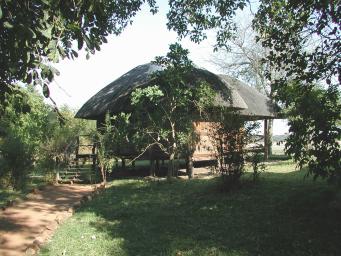
| After landing in Mfuwe we traveled overland to the Kafunta River Lodge in the South Luangwa Valley, part of the Great Rift Valley of Africa. The lodge is situated on the bank of the Luangwa River, adjacent to South Luangwa National Park, home to a wide variety of mammals and more than 450 species of birds. Accommodations are in "chalets" on stilts overlooking the river. The grunts of the abundant hippopotamus in the river can be heard day and night. |
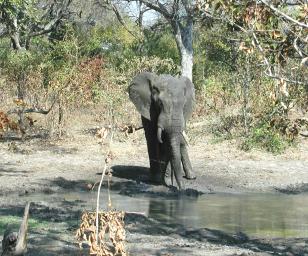
| South Luangwa National Park is home to large population of African Elephants. Elephants are very destructive to vegetation. One of the members of the tour described an area frequented by a group of elephants as looking like it had been "nuked". Shortly after passing through this area we came upon this tentacle-nosed obliterator at a water hole (actually more of a mud puddle), almost entirely covered in mud, which it was splashing on itself with its trunk. One of the disadvantages of being an elephant is the need to scoop up mud with your nose. (This does, of course, mean you can sling mud with your nose, which has its attractions.) Elephants take mud baths and wallow in mud in order to remove ticks and other parasites from their hide. The mud dries around the ticks, which are pulled off when the elephant scrapes off the mud against the trunk of a tree. In elephant country you'll see tree trunks "plastered" with mud by this maneuver. Frequently, the bark is stripped from the tree in the process or the trunk is shattered outright, further contributing to the devastation of the landscape. |

| South Luangwa also provided our first close-up look at Giraffes (Giraffa camelopardalis), which we'd only seen from a distance earlier along the Zambezi. This mother and calf were part of a herd of about a dozen we spotted near the start of a late afternoon/dusk game drive. Most of the herd dispersed into a stand of trees as we approached, but this pair were more curious. |
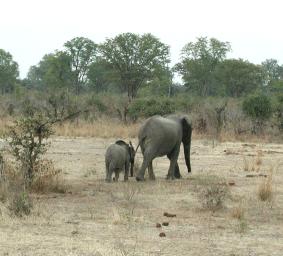
| This elephant mother and baby were part of a group of five we encountered toward dusk (the original picture is quite dark--I've enhanced the brightness in the image here). They were moving away from us when we arrived and shortly disappeared into the trees in the background. |
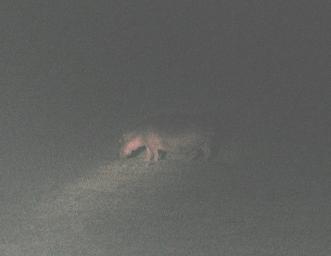
| Look, I know this is an awful picture, but it's the only close-up I got of a hippopotamus on land. Hippos generally leave the water to graze only at night. If you manage to see one on the land at all, odds are it will be in darkness when photographic conditions are marginal at best. If you go on one of these photo safaris, it's an excellent idea to bring a video camera with good low light performance, as you'll encounter nocturnal animals which can't be photographed any other way. Even though the CCD sensors used in digital still cameras have high quantum efficiency, no non-professional digital still camera I know of is adequate for circumstances like this. |
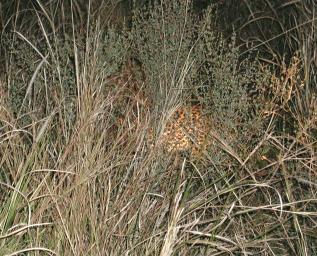
| Okay, this is another stinker, but if you look closely through the brush you'll see the unmistakable spots of a Leopard (Leo pardus)--a sight doubtless often the last glimpsed by its prey. We had reached the end of the evening game drive, left the National Park, and were on the road back to the camp when two impala bounded across the road followed shortly thereafter by this leopard. I got several excellent views as the animal crossed the road and then walked down an embankment on the side. But since I'd put the camera away, by the time I could get it out, turn it on, and try to take a picture, the leopard had walked into a thicket. Leopards can get big--up to 90 kg and 1.5 metres long. This was a smaller one--perhaps a female or juvenile. Spotting this leopard was an unexpected treat--they are nocturnal and solitary and even though the South Luangwa Valley has the reputation of being the best place to see one, many visitors never do. With this sighting we checked off the last box of the "African Big Five": Lion, Leopard, Elephant, Rhino, and Buffalo. |
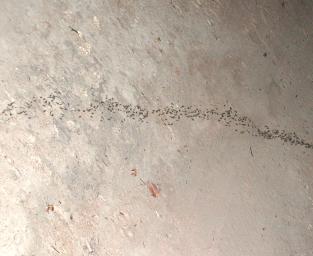
| You can hardly expect a Fourmilab expedition to come back without any pictures of ants! Here is a column of black ants, each almost a centimetre in length, extending from their colony (invisible in the brush) to the carcass of an animal (out of the frame to the left) they were scavenging. This photo was taken by night, illuminated by the spotter's light. The carcass the ants were stripping was insufficiently illuminated to photograph and indistinguishable in any case, probably already worked over by vultures and hyenas before the arthropodal clean-up crew arrived on the scene. |
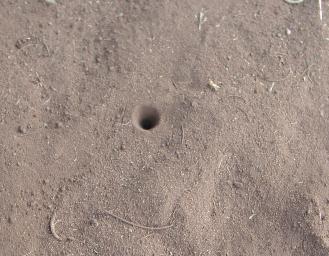
| In sandy soil in southern Africa you'll often encounter small (about 2cm) conical pits like this one. These are dug by Antlions, larvæ of insects of the family Myrmeleontidae. An Antlion is a pint-size version of the Sarlacc sand monster in Return of the Jedi--it lurks at the bottom of the pit it's dug and devours anything unlucky enough to fall in, principally ants. A voracious feeder, it eventually metamorphosises into a flying insect resembling a dragonfly. |
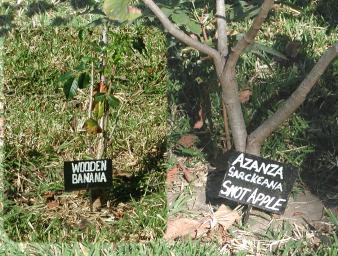
| The grounds of Kafunta River Lodge are landscaped with native trees, most with signs identifying them. Well, I ate the Mopani worms, but I think I'll pass on the fruit of these two trees. There's an error in the scientific name of the "Snot Apple"--it should actually be Azanza garckeana The "Wooden Banana" tree (Entandrophragma caudatum), which grows quite large, is also called the Mountain Mahogany. |
| Eclipse Day | |
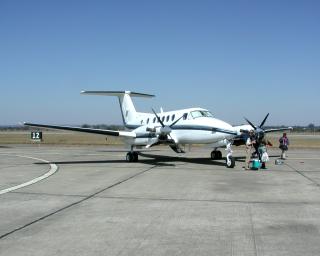
| On the morning of the eclipse we boarded our chartered Beechcraft King Air, ZS-NOW, at Mfuwe airport to fly to Lusaka. |
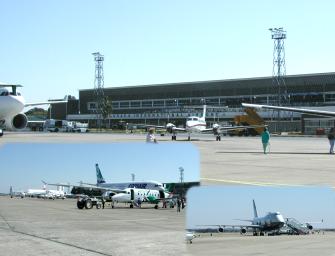
| The city of Lusaka, including the airport, was entirely within the path of totality. On the tarmac were several large airliners, including a British Airways 747, which flew in eclipse chasers the morning of the eclipse. They viewed the eclipse from the grounds of the airport and left the same day. |
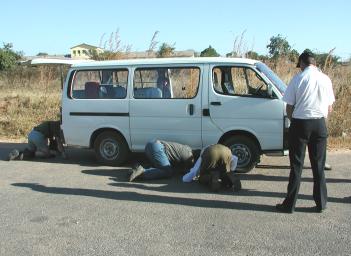
| The last thing you want on eclipse day is transportation trouble. The van which ferried us between Lusaka International and our observing site suffered a flat tyre, but thankfully after the eclipse. How many eclipse chasers does it take to change a wheel? Don't ask, they're sure to take umbrage. |
| South Africa | |
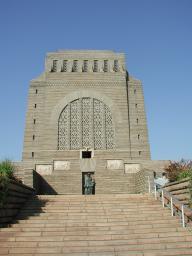
| The Voortrekker Monument outside Pretoria was completed in 1949. Inside is a marble frieze containing 27 panels commemorating events of the Great Trek in which settlers of Dutch origin emigrated from Cape Colony to the Transvaal between 1835 and 1854. At the centre of the monument is the cenotaph which bears the inscription "We for thee, South Africa". An opening in the dome atop the monument is positioned so that every year at noon on the 16th of December a beam of sunlight illuminates the cenotaph. Prior to the 1994 elections which brought Nelson Mandela to power, December 16th was celebrated as the "Day of the Vow", commemorating the massacre of the Zulus in the Battle of Blood River; it remains a holiday but is now called "Reconciliation Day". Surrounding the monument is a circular wall with reliefs representing the wagons of voortrekkers pulled into a circle. |
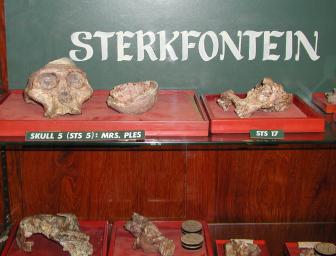
| In a locked vault (the "Broom Room") in the basement of the Transvaal Museum in Pretoria is the skull of "Mrs. Ples", the first adult specimen of Australopithecus africanus discovered. It was found on April 18, 1947 by Dr. Robert Broom at the Sterkfontein Caves near Johannesburg. The name "Mrs. Ples" comes from the original name given to the species, Plesianthropus--almost human. The skull is approximately 2.5 million years old. Australopithecus africanus walked upright and had a brain approximately the size of a modern chimpanzee's. This skull remains the most complete known cranium of the species. The public exhibit in the museum is a cast replica of the fossil shown here. |
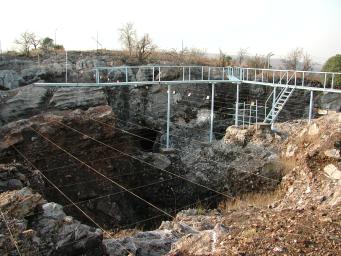
| Excavations at Sterkfontein continue to the present day. A reference grid is seen in this view of the region in which the skull of Mrs. Ples was discovered. A plaque commemorating the discovery is visible on the far side of the excavation at the site where the skull was found. |
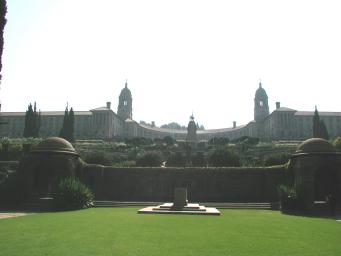
| Union House in Pretoria is the seat of the South African government (the legislature sits in Cape Town and the judiciary in Bloemfontein). The building is set on a hill overlooking Pretoria and is surrounded by extensive meticulously maintained gardens. I was enormously impressed by these gardens when I first visited South Africa in 1991 and found them just as magnificent ten years later. Union House was originally built as the capitol of the Union of South Africa, established in 1910, incorporating the former British colonies of the Cape and Natal, and the Transvaal and Orange Free State, conquered by the British in the Anglo-Boer War of 1899-1902. This view of Union House is taken from the lawn in the middle of the gardens, unfortunately backlit by the low noontime Sun of southern hemisphere winter. |

| Even on vacation, you can't get away from broken links! Here's the giant screen above the baggage claim carousel at Johannesburg airport bearing a message all too familiar to denizens of the Web. |
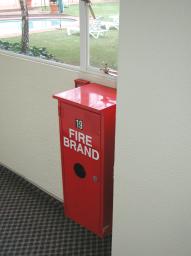
| This box was right outside the hotel room we stayed in our last night in South Africa. Sure, I know that "brand" is the word for "fire" in Afrikaans (and Dutch...and German), but I thought the juxtaposition was rather nice. The hotel, in Sandton, about mid-way between Johannesburg and Pretoria, resembled an armed compound, surrounded by a high wall with razor wire and electrically operated gates. Every time I saw this box I imagined myself running down the hall screaming and waving a flaming torch. |
 Back to Eclipse 2001
Back to Eclipse 2001